Luciana Cioca is a PhD student at Babeș-Bolyai University, Cluj Napoca, Romania, studying the history of the vesperial disputations at medieval universities. She is also a Research Assistant in the Project PN-III-P4-ID-PCCF-2016-0064 “The Rise of an Intellectual Elite in Central Europe: The University of Vienna from 1389 to 1450,” coordinated by Dr. Adinel Dincă and Dr. Monica Brînzei, and hosted by Babeș-Bolyai University and The Romanian Academy. Rise Team: Alexandra Baneu, Alexander Baumgarten, Cristian Baumgarten, Luciana Cioca, Daniel Coman, Paula Cotoi, Ioana Curuț, Iulian-Mihai Damian, Lavinia Grijac, Edit Anna Lukács, Mihai Maga, Andrei Marinca, Mădălina Gabriela Pantea, Isabela Stoian.

When Project PN-III-P4-ID-PCCF-2016-0064, or, Rise Project, as we call it, started back in 2017, the collaborative effort of its members was directed towards a simple goal: the complete transcription of a medieval notebook with miscellaneous content, belonging to Henry of Rinfeldia.
All other research avenues emerged from this core idea.
This blogpost is thus dedicated to answering one question: why has this manuscript been singled out?
Codex A X 44
To say that MS. Basel, Universitätsbibliothek A X 44 has miscellaneous content is an ironic understatement. Ironic, because its miscellany is utterly intertwined with one of the most challenging features of this notebook: its internal cohesion. Understatement, inasmuch as the simplest of questions about it would see any member of the project start an accidental exhortation on how diverse, yet concrete, how frustrating, yet intriguing the manuscript can be.
Indeed, MS. Basel A X 44 contains a variety of questions, notes, sermons, conclusions, and other types of smaller texts. They range from topics such as the breadth of species to divine prescience, from theories of knowledge to sermons, from astrology to matters of the body, and many, many more. Their full list can be consulted here.
The manuscript is a real ‘notebook,’ written by Henry of Rinfeldia during his student years at the University of Vienna. It’s worth noting, though, that although Rinfeldia’s is the main hand in the notebook, other hands are also represented in it. The dates reflected by the codex, as stated in the manuscript itself, range from 1394 to 1397.
I say ‘real notebook’ because anyone looking at the manuscript would probably recall their own university years, scribbling notes in the margins, dropping personal information and small reminders here and there, breaking a section to start a new one, inserting sheets of paper, and, most importantly, recording the lectures of one’s professors.

Even though Rinfeldia’s hand covers the largest part of the notebook, there are other hands in it as well. One of the earliest interactions with the manuscript quickly exposed its primary merit: Henry had recorded the lectures taking place at the university during his time. This kind of valuable insight into the Viennese intellectual space on its own would have warranted extensive studies, but our witness went even further to document the first generation of professors teaching at the newly founded Faculty of Theology.
Two main groups stood out. The first, and perhaps the most immediately rewarding, included professors whose names are not associated with any extant work, their only historical presence being limited to registries or statutes. The process of finding anything at all about them taught us a lot about the limits of Google and the availability of data.

The second group included medieval ‘celebrities’. Henry of Langenstein (Hassia) and Henry of Oyta, the founders of the Faculty of Theology in Vienna, have a considerable presence in the manuscript. However, as the transcription advanced, one thing became evident: Rinfeldia’s main source, the dominant source throughout the notebook, was Henry of Langenstein.
Langenstein’s dominance soon provided research breakthroughs of its own. The growing stream of content allowed not only for a survey of his teaching in Vienna, but also for an improved and greatly enriched picture of his background in Paris, where he studied theology and received his doctorate in 1376.
From the very beginning, the scale of our discoveries was naturally connected to the types of challenges such a manuscript poses, some of which are yet to be solved even though the transcription is almost complete.
A personal favourite of mine is the puzzle-like structure of some parts. Now, there are many subtypes and also unique situations, each deriving from either space management or simple chronology. But for the purposes of this blog post, I would like to outline one of the clearest examples. The following Latin transcription was carried out by Alexandra Baneu.
At f. 11r, a paragraph sign announces a quasi-independent section comprising a succession of corollaries. As they are separated from the previous text by an empty line, they seem to have previously belonged elsewhere. This in itself indicates that the section has been cut off from its original context. Upon reading the corollaries, one discovers another layer of fragmentation, marked with direct references to other folia.
One corollary reads:
Quamvis infinite denominationes, quarum quelibet dicit perfectionem simpliciter, convenire possent [possit coni] creaturis, nulla tamen perfectio creata est vel esse potest perfectio simpliciter.
Even though the infinite denominations, each of which is said to be singular perfection, can befit the creatures, no created perfection is, or can be, singular perfection.

This corollary ends on this folio as follows:
Conclusionem secundam quere in folio sequenti, que est ‘omnis quantitas’ etc.
Find the second conclusion on the following folio, which begins ‘the entire quantity’ etc.
This indicates that the corollaries on f. 11r are associated with a first conclusion.

If we do exactly what the scribe tells us, we find, at f. 12v, a section marked “The second conclusion,”. This begins:
Conclusio secunda. Omnis quantitas perfectionis essentialis creature […].
The entire quantity of the essential perfection of the creature […]
Excellent. Henry had interrupted his first conclusion and added the corollaries somewhere else. He then added the second conclusion on another folio.

But then, at the end of the second conclusion, we read:
Quartum corollarium huius conclusionis quere in cedula
Find the fourth corollary of this conclusion in the schedule.

A schedule is a smaller piece of paper inserted between two folia.

Since the next schedule is at f. 37, it is unlikely that it is where we need to look. So we go back to f. 10, where we find the relevant schedule and:
Corollarium quartum secunde conclusionis
The fourth corollary of the second conclusion.

But in the same place, before our fourth corollary, we see a set of other corollaries, marked from 1 to 6, with the second one pointing somewhere else, and the third missing. The sixth reads:
Sextum: ‘quamvis infinite denominationes’. Patet in quaterno
The sixth : ‘even though the infinite denominations’. This is to be found in the quaternion.

And where should this be, if not back at f. 11r, where it all began? And not only that, but at f. 11r, before the corollary starting with ‘even though the infinite denominations’, there’s another reference to content added in the schedule:
Quere quartum et quintum in cedula
Find the fourth and fifth in the schedule

All right. Let’s piece this all back together.
There was an initial conclusion 1 at f. 10v, which had 6 corollaries. They were all listed in the schedule at f. 10. The first one is complete, the second one points to another place, the third one is missing, the fourth and fifth are complete, and the sixth sends us back to the quaternion. The reference is to f. 11r, where we find the incomplete second corollary, the missing third corollary, a mention that the fourth and fifth corollaries are in the schedule, and the complete sixth corollary. We are also referred to the following folio for the second conclusion.
We find the second conclusion at f. 12v. This one has four corollaries. The first three are on the same folio, but the fourth, we are told, is in the schedule – the same one containing the corollaries of the previous conclusion. And we do indeed find the fourth there.
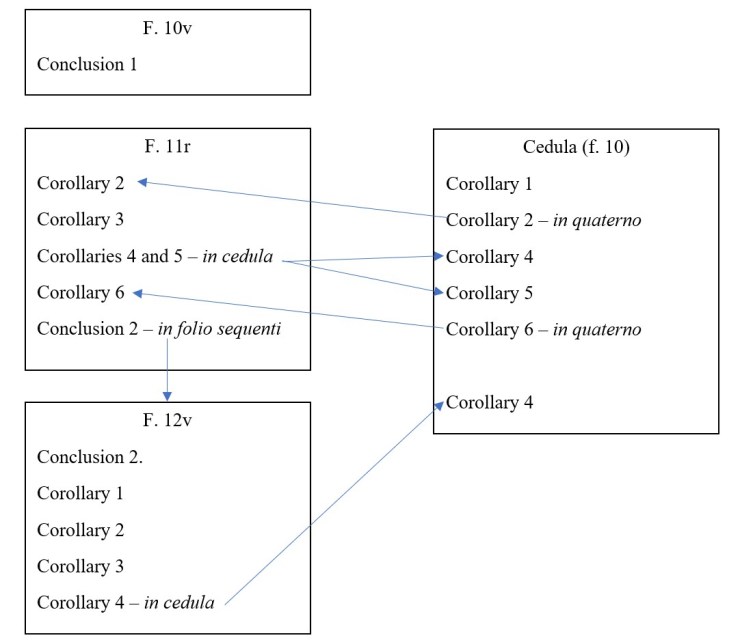
Because the manuscript is meant for personal use, the structural liberties taken by the scribe are numerous, and I hope I’ve succeeded in conveying just how complex they can be.
More research should bring to light the full extent of Rinfeldia’s methodology along with its other, more surprising ramifications.
Rinfeldian opportunities
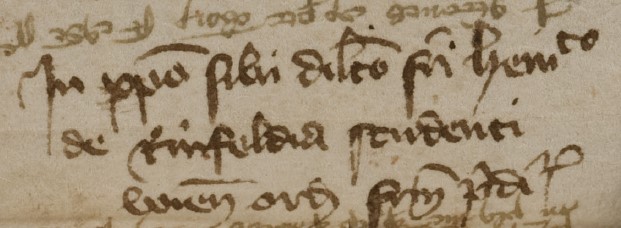
After two years of constant ‘dialogue’ with him, it is quite easy to forget that Henry of Rinfeldia is not a recognizable name, even for medievalists. He had not advanced doctrinal views to compete with the via antiqua, nor even with the via moderna. He had not challenged the field of philosophy with the kind of cutting edge theories which would just about pass the academic hierarchy’s heresy detectors. If these are our standards, then Rinfeldia falls short. And this is fair enough, for it is not the duty of each and every medieval scribe to be recognised for contributions to doctrinal novelty.
The discoveries produced by research into Rinfeldia and his notebook are therefore of a different nature. They paint a vivid picture of academic life, brimming with debates and intellectual exchanges, bringing to light long forgotten actors, and paving the way for the next generation of students to master the craft of correct syllogism and compelling argument. They tap into the intellectual trends that characterized the times, into the scholastic culture that Vienna imported from centres with more historical heritage, like the University of Paris, mainly through Henry of Langenstein and Henry of Oyta. Rinfeldia shows us what was of interest in Vienna when he was a student, the positions and the controversies, what was preserved and what was changed.
There’s a recurrent back and forth in the notebook, evocative of live debates, and not just featuring the professors Rinfeldia heard himself…
Henricus de Hassia dicit quod […]
Henricus de Oyta dicit quod […]
Decimo sexto queritur quare […]
Respondit Henricus de Hassia quod […]
Henry of Hassia says that […]
Henry of Oyta says that […]
In the 16th place, it is asked why is […]
Henry of Hassia answered that […].
(Basel A X 44, f. 68r)
Magister Henricus de Hassia dicit quod […].
Henricus de Oyta dicit quod […]
Aliqui dixerunt quod […].
Nota: Henricus de Oyta dicit quod […].”
Master Henry of Hassia says that […]
Henry of Oyta says that in the union […]
Others said that […]
Note: Henry of Oyta says that […]”
(Basel A X 44, f. 69r)
…but also the arguments he himself advanced:
Hoc arguit Henricus de Hassia. Sed videtur michi posse dici […].
This is argued by Henry of Hassia. It seems to me, however, that one can say that […]
(Basel A X 44, f. 67v)
This notebook provides many avenues for understanding the connection between Rinfeldia and Langenstein (Hassia), and many of them are yet to be explored.
Transcription Process
I would now like to move onto the more technical side of things, I will begin by repeating one of the main goals of this project: to offer a free online transcription of the contents of MS. Basel A X 44. The team has started a video series showing the working method that makes this possible.
Because the level of textual fragmentation was not clear at first, the content was simply divided by folia, following only the larger segments, such as the ones introduced by a title of sorts, regardless of content. Each of us is in charge of transcribing around fifteen folia.
A three-level progression was designed for this process. Level 1 saw content being transcribed in as much volume as possible. We simply copied the text in no particular order, and with no particular regard for punctuation, internal references, or sources. This was mainly to show the breadth of the work and to be able to make predictions for both timelines and resources. Once a raw version was available, the team punctuated the text, following its internal meaning and logic, and made it more ‘presentable’ for Level 2.

Level 2 was, and still is, exclusively team work. Daily video conferences were set up to check the transcription against the manuscript line by line, as shown in the videos. This means that every single folio is checked by the entire team. Even though mistakes are inevitable, having many pairs of eyes look at the same thing at the same time considerably lowers the error rate.
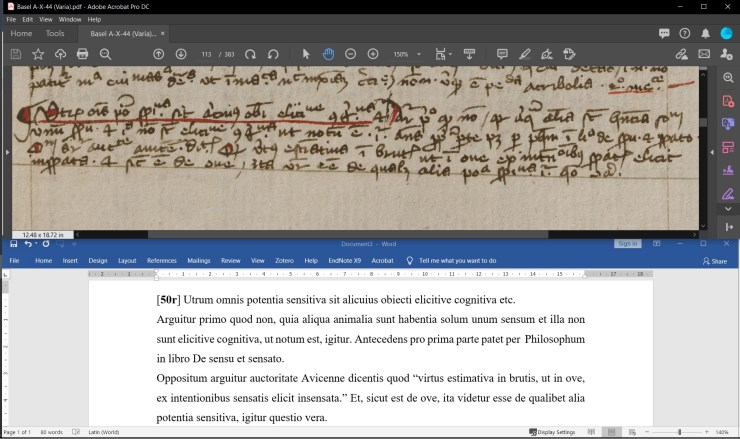
Level 3, in fact, blends in with 1 and 2, as it doesn’t necessarily follow them chronologically. It is represented by a final edited version of the manuscript to be uploaded online, but the steps leading up to this included a more detailed look at the content itself. The result is a volume gathering articles written by the team, each of them analysing an author or text they found useful for their own research interests.[1]
At the time of writing this post, we are still in a combination of levels 2 and 3. We’re trying to figure out the best way to publish the edition online, especially with regards to conveying the structural complexity that I’ve shown above.
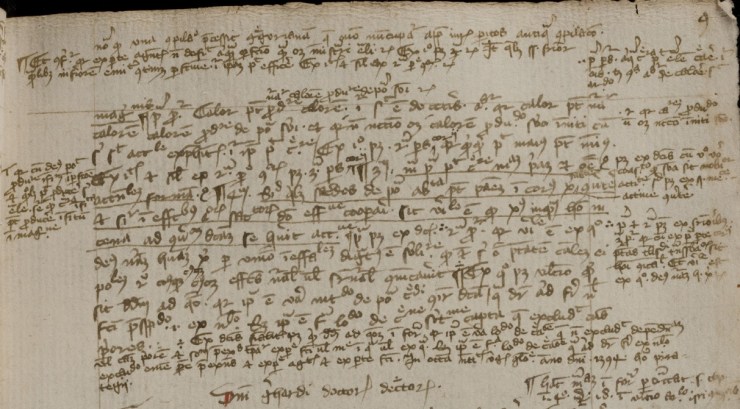
So, why MS. Basel A X 44?
This question warrants many and diverse answers, but ultimately they all lead to one main answer: it greatly benefits a large number of subjects: palaeography and codicology, the history of universities and the individuals connected with them, medieval philosophy, political philosophy, the history of ideas, and even general history.
The scope of this answer might seem so broad as to be a little bland, but it really is the only one that can accurately encapsulate the breadth of what the manuscript has to offer. The excitement has already moved on to the question of how!
[1] See the forthcoming Notes from the Classroom Recorded by Henry of Rinfeldia. A Medieval Case-Study from the University of Vienna, edited by M. Brînzei and A. Baneu.
Luciana Cioca, Babeș-Bolyai University
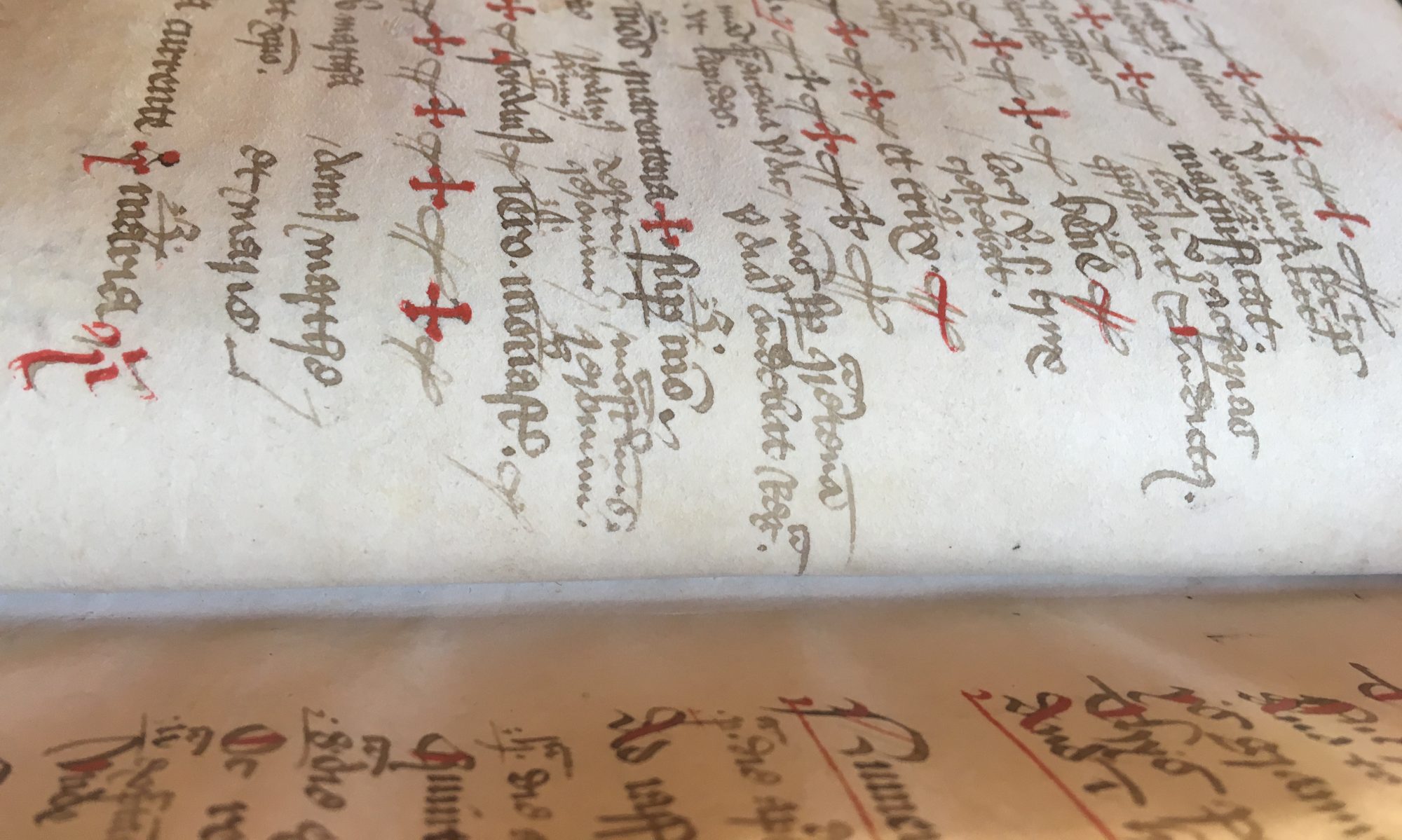






One Reply to “”